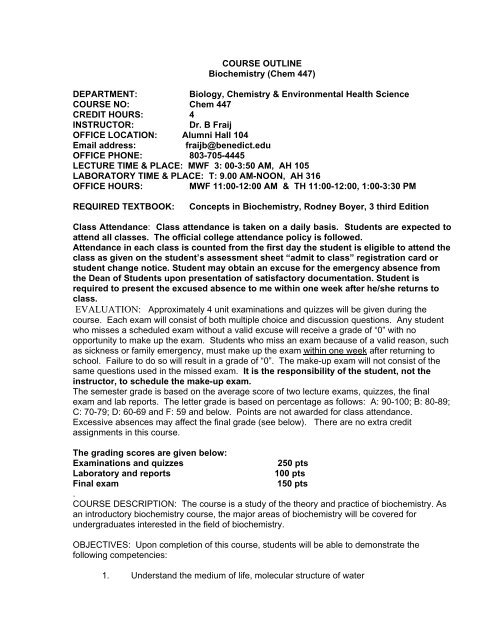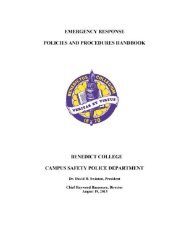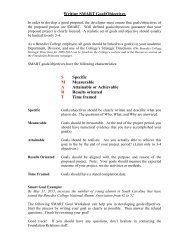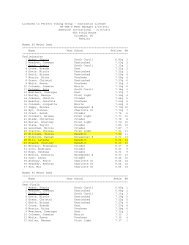Chem 447 syllabus - Benedict College
Chem 447 syllabus - Benedict College
Chem 447 syllabus - Benedict College
Create successful ePaper yourself
Turn your PDF publications into a flip-book with our unique Google optimized e-Paper software.
COURSE OUTLINEBiochemistry (<strong>Chem</strong> <strong>447</strong>)DEPARTMENT:Biology, <strong>Chem</strong>istry & Environmental Health ScienceCOURSE NO: <strong>Chem</strong> <strong>447</strong>CREDIT HOURS: 4INSTRUCTOR:Dr. B FraijOFFICE LOCATION: Alumni Hall 104Email address:fraijb@benedict.eduOFFICE PHONE: 803-705-4445LECTURE TIME & PLACE: MWF 3: 00-3:50 AM, AH 105LABORATORY TIME & PLACE: T: 9.00 AM-NOON, AH 316OFFICE HOURS:MWF 11:00-12:00 AM & TH 11:00-12:00, 1:00-3:30 PMREQUIRED TEXTBOOK:Concepts in Biochemistry, Rodney Boyer, 3 third EditionClass Attendance: Class attendance is taken on a daily basis. Students are expected toattend all classes. The official college attendance policy is followed.Attendance in each class is counted from the first day the student is eligible to attend theclass as given on the student’s assessment sheet “admit to class” registration card orstudent change notice. Student may obtain an excuse for the emergency absence fromthe Dean of Students upon presentation of satisfactory documentation. Student isrequired to present the excused absence to me within one week after he/she returns toclass.EVALUATION: Approximately 4 unit examinations and quizzes will be given during thecourse. Each exam will consist of both multiple choice and discussion questions. Any studentwho misses a scheduled exam without a valid excuse will receive a grade of “0” with noopportunity to make up the exam. Students who miss an exam because of a valid reason, suchas sickness or family emergency, must make up the exam within one week after returning toschool. Failure to do so will result in a grade of “0”. The make-up exam will not consist of thesame questions used in the missed exam. It is the responsibility of the student, not theinstructor, to schedule the make-up exam.The semester grade is based on the average score of two lecture exams, quizzes, the finalexam and lab reports. The letter grade is based on percentage as follows: A: 90-100; B: 80-89;C: 70-79; D: 60-69 and F: 59 and below. Points are not awarded for class attendance.Excessive absences may affect the final grade (see below). There are no extra creditassignments in this course.The grading scores are given below:Examinations and quizzes250 ptsLaboratory and reports100 ptsFinal exam150 pts.COURSE DESCRIPTION: The course is a study of the theory and practice of biochemistry. Asan introductory biochemistry course, the major areas of biochemistry will be covered forundergraduates interested in the field of biochemistry.OBJECTIVES: Upon completion of this course, students will be able to demonstrate thefollowing competencies:1. Understand the medium of life, molecular structure of water
2. Describe the buffer selection3. Describe amino acids and proteins4. Describe the molecular structure of proteins5. Understand functional diversity of proteins, myoglobin and hemoglobin6. Outline a general scheme for protein purification and explain techniques7. Understand enzyme catalysis and inhibition8. Define the most abundant biomolecules on earth, carbohydrates9. Discuss the carbohydrate metabolism10. Explain different types of metabolic pathways and ATP formation11. Understand lipids12. Discuss lipid metabolism13. Explain DNA and RNA structure14. Understand DNA replicationMAIN TOPICSI. Introduction to molecular structure of watera. Water is a polar moleculeb. Solvent properties of waterc. Ionization of water, acids and basesd. Buffer selection, Henderson-Hasselbalk equationII. Amino acids and peptidesa. The building blocks of proteinsb. Physiological interest of amino acidsc. Amino acids and proteins as acids and bases/ solving problemsd. Protein structuree. Protein sequencingf. Protein purificationsg. Analytical methods and techniquesh. Enzyme kineticsi. Enzyme inhibitionIII. Carbohydratesa. Aldoses, ketoses, formation of hemiacetalsb. Disaccharides, homopolysaccharides, heteroploysaccharidesc. Glycolysisd. Gluconeogenesis, pentose phosphate pathwaye. Aerobic metabolismf. Oxidative phosphortlationg. Antioxidant systemsIV.lipidsa. Fatty acids, triglycerides, neutral fatsb. Phospholipids and cell membranec. Sterolsd. Lipid metabolisme. Health effect of lipidsV. Nucleic acidsa. DNA and RNA structuresb. Gene expressionc. Polymerses
















